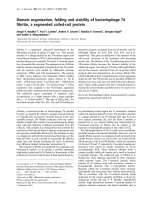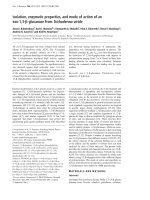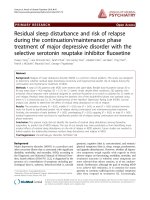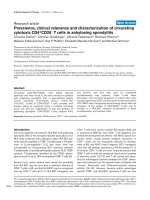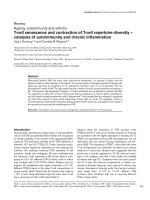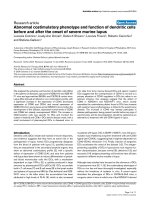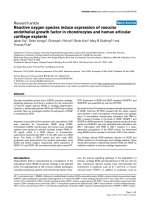Báo cáo y học: "Comprehensibility, reliability, validity, and responsiveness of the Thai version of the Health Assessment Questionnaire in Thai patients with rheumatoid arthritis" potx
Bạn đang xem bản rút gọn của tài liệu. Xem và tải ngay bản đầy đủ của tài liệu tại đây (121.29 KB, 8 trang )
Open Access
Available online />Page 1 of 8
(page number not for citation purposes)
Vol 11 No 4
Research article
Comprehensibility, reliability, validity, and responsiveness of the
Thai version of the Health Assessment Questionnaire in Thai
patients with rheumatoid arthritis
Manathip Osiri
1
, Jeerapat Wongchinsri
2
, Sitthichai Ukritchon
3
, Punchong Hanvivadhanakul
4
,
Nuntana Kasitanon
5
and Boonjing Siripaitoon
6
1
Division of Rheumatology, Department of Medicine, Faculty of Medicine, Chulalongkorn University, 1873 Rama IV Road, Pathumwan, Bangkok
10330, Thailand
2
Department of Medicine, Nopparat Rajathani Hospital, 109 Ramindra Km, 12 Kunnayao, Bangkok 10230, Thailand
3
Division of Rheumatology, Department of Medicine, Srinakharinwirot University, Princess Maha Chakri Sirindhorn Medical Center, 63 Moo 7, Rangsit-
Ongkharak Road, Ongkharak, Nakorn-Nayok 26120, Thailand
4
Division of Rheumatology, Department of Medicine, Faculty of Medicine, Thammasat University, Paholyotin Road, Amphur Klongluang, Pathumthani
12120, Thailand
5
Division of Rheumatology, Department of Medicine, Faculty of Medicine, Chiang Mai University, 110 Intawaroros Road, Amphur Muang, Chiang Mai
50200, Thailand
6
Division of Rheumatology, Department of Medicine, Faculty of Medicine, Prince of Songkla University, 15 Karnjanavanit Road, Hat Yai, Songkhla
90110, Thailand
Corresponding author: Manathip Osiri,
Received: 17 Mar 2009 Revisions requested: 15 May 2009 Revisions received: 10 Aug 2009 Accepted: 27 Aug 2009 Published: 27 Aug 2009
Arthritis Research & Therapy 2009, 11:R129 (doi:10.1186/ar2796)
This article is online at: />© 2009 Osiri et al.; licensee BioMed Central Ltd.
This is an open access article distributed under the terms of the Creative Commons Attribution License ( />),
which permits unrestricted use, distribution, and reproduction in any medium, provided the original work is properly cited.
Abstract
Introduction The Health Assessment Questionnaire Disability
Index (HAQ-DI) is a commonly used instrument to assess
functional status of patients with rheumatoid arthritis (RA).
Translations and adaptations of the HAQ-DI have been carried
out for use with RA patients in several countries. The objective
of this study was to evaluate the psychometric properties of the
Thai version of the HAQ-DI (Thai HAQ) in Thai patients with RA.
Methods Comprehensibility of the Thai HAQ was assessed by
126 patients with RA from 6 medical centers in Thailand.
Another group of 115 patients with active RA was enrolled to
test the reliability (internal reliability and 1-week test-retest
reliability), construct validity (correlations with other measures of
RA disease activity), floor and ceiling effects, and sensitivity to
change of the Thai HAQ at 3 months of treatment with disease-
modifying antirheumatic drugs.
Results More than 98% of the patients regarded the Thai HAQ
as comprehensible. The internal consistency of the Thai HAQ
was satisfactory with the overall Cronbach alpha of 0.91. The
test-retest reliability of the Thai HAQ was acceptable with the
intraclass correlation coefficient of 0.89. Moderate correlations
between the Thai HAQ and other outcomes of RA disease
activity were observed, except erythrocyte sedimentation rate,
with the Spearman correlation coefficients ranging from 0.42 to
0.57. The responsiveness of the Thai HAQ was moderate, with
a standardized response mean of 0.75 (95% confidence interval
0.56 to 0.94).
Conclusions The Thai HAQ is comprehensible, reliable, valid
and sensitive to change in the evaluation of functional status of
Thai patients with RA. The Thai HAQ is an essential tool to
measure treatment effects and progression of disability in RA
patients and should be applied in both clinical trials and routine
clinical care settings.
ACR: American College of Rheumatology; CI: confidence interval; DMARD: disease-modifying antirheumatic drug; ESR: erythrocyte sedimentation
rate; HAQ: Health Assessment Questionnaire; HAQ-DI: Health Assessment Questionnaire Disability Index; ICC: intraclass correlation coefficient;
OMERACT: Outcome Measures in Rheumatology Clinical Trials; RA: rheumatoid arthritis; SD: standard deviation; SRM: standardized response
mean; Thai HAQ: Thai version of the Health Assessment Questionnaire Disability Index.
Arthritis Research & Therapy Vol 11 No 4 Osiri et al.
Page 2 of 8
(page number not for citation purposes)
Introduction
The Stanford Health Assessment Questionnaire (HAQ) was
originally developed to measure five important health out-
comes in patients with chronic diseases [1,2]. These dimen-
sions include premature death, functional disability, pain and
discomfort, adverse effects of treatment, and costs. The HAQ
Disability Index (HAQ-DI), the HAQ section to evaluate func-
tional capacity, is the most commonly used instrument for
assessing disability in patients with rheumatoid arthritis (RA).
The HAQ-DI is a predictive factor of future disability and joint
damage in patients with RA [3-5]. Because it demonstrated
sensitivity to change, the HAQ-DI was chosen by the Outcome
Measures in Rheumatology Clinical Trials (OMERACT) and
the American College of Rheumatology (ACR) to be incorpo-
rated into the core set of outcome measures of RA disease
activity [6-8]. The HAQ-DI not only is considered an essential
measure of disability in patients with RA in clinical trials, but
also is used in clinical practice.
The HAQ-DI has been translated and adapted to suit the activ-
ities and cultures in diverse populations from more than 50
countries [9,10]. As with the original HAQ-DI, a number of
translations of the HAQ-DI into other languages have been
proven to be reliable, valid, and sensitive to change. For the
Thai version of the HAQ-DI (Thai HAQ), three items were
adapted and two activities were added to the existing items to
tailor the questionnaire to the lifestyle and culture of Thai peo-
ple. The Thai HAQ was back-translated and tested for its valid-
ity and responsiveness in a pilot study at a tertiary care
hospital in Thailand [11]. However, psychometric validation of
the Thai HAQ is still important if it is to be recommended as a
standard instrument to measure long-term disability in Thai
patients with RA. It is also needed for demonstrating the effec-
tiveness of disease-modifying antirheumatic drug (DMARD)
therapy, especially with the expensive biologics, and for use in
guidelines to follow the patients over time. Thus, the objective
of this study was to evaluate the comprehensiveness, reliabil-
ity, validity, and responsiveness of the Thai HAQ in Thai-speak-
ing patients with RA from different parts of the country.
Materials and methods
Comprehensibility
One hundred twenty-six adult patients who met the ACR 1987
revised criteria for the classification of RA [12] were included
in the comprehensibility assessment of the Thai HAQ. These
patients were enrolled from six medical centers in Thailand
from January to April 2006 regardless of their disease activity.
The comprehensibility questionnaire was self-reported by the
patients. For older patients and those with poor eyesight, the
responses were performed with the assistance of relatives
who accompanied them and of rheumatology nurses at the
clinics. The patients were asked whether they understood the
20 items from the eight domains of the Thai HAQ. The levels
of comprehensibility for each item were categorized on a 4-
point scale (0, not comprehensible; 1, slightly comprehensi-
ble; 2, moderately comprehensible; and 3, highly comprehen-
sible). Scores of 2 or more for each item were regarded as
comprehensible.
Reliability, validity, and responsiveness
From the same six institutes, 115 more patients with RA were
consecutively selected between January 2006 and July 2007
to be included in this part of study. Each patient had to fulfill all
of the following criteria: (a) met the ACR 1987 revised criteria
for the classification of RA [12], (b) was at least 18 years of
age, and (c) had active disease characterized by (i) at least six
tender joints, (ii) at least six swollen joints, (iii) a Westergren
erythrocyte sedimentation rate (ESR) of at least 28 mm/hour,
and (iv) at study entry, just starting a non-biologic DMARD, an
increase in the dose of a non-biologic DMARD, or the addition
of another non-biologic DMARD. The patients were excluded
if they were pregnant or breastfeeding, receiving prednisolone
at a dose of more than 10 mg per day, or did not give informed
consent. The mode of Thai HAQ administration was similar to
that of the comprehensibility assessment. The assessments of
reliability, validity, and responsiveness of the Thai HAQ were
conducted in accordance with the OMERACT filter for out-
come measures in RA [8]. Both parts of the study protocols
were approved by the ethics committees of each institute. This
study was conducted in accordance with the Declaration of
Helsinki. All patients were required to give written informed
consent before entering this study.
The Thai HAQ
The Thai HAQ included 20 items from eight domains adapted
from the original HAQ-DI to suit Thai culture and activities. The
ability to perform an activity for each item is rated on a 4-level
scale, in which the score ranges from 0 (no difficulty in per-
forming that activity) to 3 (inability to perform that activity). The
requirement of a device or physical assistance in any item
increases the lower score to 2. To calculate the HAQ-DI score,
the maximum scores from each domain were summed and
divided by 8 to yield a score that ranged from 0 to 3. The
higher score indicated greater disability.
Statistical analysis
Baseline characteristics of the studied patients were pre-
sented as number and percentage for discrete parameters
and as mean and standard deviation (SD) for continuous
parameters. Comprehensibility assessment of the Thai HAQ
was presented as percentage of patients with moderate or
high comprehensibility in the Thai HAQ.
Reliability
Reliability was assessed by test-retest reliability and internal
consistency. The test-retest reliability was performed with a 1-
week interval. This interval was used because the patients
would not be able to remember the first test and the effects of
DMARDs added were not expected at 1 week of treatment.
Available online />Page 3 of 8
(page number not for citation purposes)
The patients completed the first Thai HAQ at their clinic visits.
The second was sent to them by mail. Test-retest reliability of
the Thai HAQ was analyzed using intraclass correlation coef-
ficients (ICCs). The ICCs and their 95% confidence intervals
(CIs) were calculated using a two-way random-effects model.
An ICC value of 0.85 or higher was considered acceptable
[13]. Internal consistency among each domain of the Thai
HAQ was evaluated by Cronbach alpha using the results from
the first administration. The overall Cronbach alpha was calcu-
lated from all eight domains of the Thai HAQ. For each domain,
Cronbach alpha was obtained by deleting that domain from
the questionnaire [14].
Validity
Construct validity of the Thai HAQ was performed by correlat-
ing the baseline eight domains and total scores of the Thai
HAQ with the following outcome measures of RA disease
activity: number of tender joints (total 68 joints), number of
swollen joints (66 joints), patient's assessment of pain, patient
global assessment of disease activity, physician global
assessment of disease activity, and ESR. Pain score and
patient and physician global assessments of disease activity
were measured on a 5-level categorical scale, in which the
higher score indicated greater pain and worse disease status.
The correlation coefficients used in this study were Spearman
correlation coefficients. Correlation coefficients of greater
than 0.6, of 0.6 to 0.3, and of less than 0.3 were considered
strong, moderate, and weak correlations, respectively [15].
The Thai HAQ was also evaluated for floor and ceiling effects.
Floor and ceiling effects were considered to be present if at
least 15% of the patients scored 0 (the lowest possible score)
or 3 (the highest possible score), respectively, on the Thai
HAQ [16].
Responsiveness
Responsiveness of the Thai HAQ and other measures of RA
disease activity was calculated from the baseline values and
the values at month 3. To assess the responsiveness of the
Thai HAQ and other parameters, the differences between
baseline and month 3 scores were used for calculating the
standardized response mean (SRM) from the formula:
The SRM value between 0.6 and 0.8 is considered moderate
effect and clinically significant. The value of greater than 0.8
represents large effect [17,18]. The statistical software used
in this study was SPSS for Windows, version 11.0 (SPSS Inc.,
Chicago, IL, USA). The statistically significant level was deter-
mined as a P value of less than 0.05.
Results
Demographic data of both groups of studied patients are
shown in Table 1. The comprehensibility of the Thai HAQ was
assessed by 126 patients, whose domiciles were distributed
in all parts of the country. Twenty-six patients (20.6%) were
from Bangkok. Among the others, 35 (27.8%) resided in Cen-
tral Thailand, 23 (18.3%) in the North, 11 (8.7%) in the North-
east or East, and 31 (24.6%) in the Southern part of Thailand.
The mean (SD) age of the studied patients was 50.5 (13.0)
years. One hundred fourteen patients (90.5%) were women.
Although 68.3% of the patients (86 patients) completed only
primary education (that is, 6 years of formal education), more
than 90% of the 126 patients scored each item of the Thai
HAQ as moderately or highly comprehensible, as shown in
Table 2.
Of the 115 patients with RA enrolled to test the reliability,
validity, and responsiveness of the Thai HAQ, 99 (86.1%)
were women. The mean (SD) age was 48.9 (11.9) years, and
SRM m ean change of the scoreSD change of the score.= /
Table 1
Demographic characteristics of studied patients
Demographic characteristics Comprehensibility assessment Reliability, validity, responsiveness assessment
Number of patients 126 115
Females/males, number (percentage) 114/12 (90.5%/9.5%) 99/16 (86.1%/13.9%)
Age in years, mean ± SD 50.5 ± 13.0 48.9 ± 11.9
Disease duration in months, mean ± SD ND 68.9 ± 71.8
Rheumatoid factor-positive patients, number
(percentage)
ND 88 (76.5%)
Formal education, number (percentage) of patients
≤6 years 92 (73.0%) 81 (70.4%)
>6 to ≤12 years 26 (20.6%) 24 (20.9%)
>12 years 8 (6.4%) 10 (8.7%)
ND, no data; SD, standard deviation.
Arthritis Research & Therapy Vol 11 No 4 Osiri et al.
Page 4 of 8
(page number not for citation purposes)
the mean (SD) disease duration was 68.9 (71.8) months.
Rheumatoid factor was positive in 77%. The mean (SD) Thai
HAQ score at baseline was 1.56 (0.75).
Internal consistency of the Thai HAQ was satisfactory, with the
Cronbach alpha of 0.910 among all eight domains. Removal of
each domain of the Thai HAQ did not produce a significant
change in the Cronbach alpha. The highest alpha was 0.899
when the dressing domain was deleted and the lowest alpha
was 0.886 when the reach or activity domain was excluded
from the Thai HAQ.
Test-retest reliability of each domain and total Thai HAQ
scores was acceptable. The average measure ICC of the Thai
HAQ was 0.89 (95% CI 0.84 to 0.92). For each domain of the
Thai HAQ, the estimates of ICC ranged from 0.77 to 0.87. The
mean and SD of each domain of the Thai HAQ at baseline and
day 7 as well as the ICCs and 95% CIs are shown in Table 3.
The Spearman correlation coefficients for construct validity of
each domain of the Thai HAQ and total Thai HAQ scores are
shown in Table 4. Moderate correlation was observed
between the majority of Thai HAQ domains as well as the Thai
HAQ and outcomes of RA disease activity. These correlation
coefficients ranged from 0.30 to 0.57. The highest correlation
coefficient was observed between the Thai HAQ and ACR
functional class (correlation coefficient 0.57), whereas the
lowest was seen between the Thai HAQ and ESR (correlation
coefficient 0.37). ESR correlated weakly with four domains of
the Thai HAQ (dressing and grooming, walking, grip, and
activity domains). The grip and walking domains of the Thai
HAQ also had weak correlations with the number of swollen
joints, number of tender joints, and pain level.
Floor and ceiling effects of the Thai HAQ were not observed
in the studied patients. At baseline, none (0%) scored 0 or 3
Table 2
Comprehensibility of each item of the Thai HAQ assessed by 126 Thai patients with rheumatoid arthritis
Thai HAQ domain Thai HAQ item Percentage comprehensibility
Are you able to:
Dressing and grooming 1. Put on clothes, including buttoning up? 100
2. Wash your hair? 100
Arising 3. Get up from a chair without armrests? 98.4
4. Lie down and get up from the bed, or sit in floor-sitting or kneeling position? 100
Eating 5. Slice food with a knife? 99.2
6. Lift up a glass (filled with water) for drinking? 99.2
7. Open up food or beverage cans? 99.2
Walking 8. Walk outdoors on level ground? 100
9. Climb up five steps of stairs? 99.2
Hygiene 10. Apply soap over the body and towel up? 100
11. Lift up a water bowl to wash yourself? 100
12. Sit down and get up from a toilet seat? 100
Reach 13. Reach for a 2-kg object from an overhanging cupboard? 98.4
14. Bend down to pick up an article from the floor? 100
Grip 15. Open a car door? 100
16. Open containers (such as conserve or Ovaltine jar)? 99.2
17. Turn on and off a faucet, or wring clothes after washing? 99.2
Activities 18. Go marketing? 99.2
19. Get on and off a car or a bus? 99.2
20. Sweep and mop? 98.4
Thai HAQ, Thai version of the Health Assessment Questionnaire Disability Index.
Available online />Page 5 of 8
(page number not for citation purposes)
on the Thai HAQ. At 3 months of treatment, 6 patients (5.2%)
scored 0 and 1 patient (0.9%) scored 3.
Responsiveness of the Thai HAQ and other measures of RA
disease activity was moderate as the SRMs were 0.6 or
higher, except for ESR. The SRM for the patient global assess-
ment of disease activity was the highest (0.94), whereas that
for the Thai HAQ was 0.75. The SRMs for the Thai HAQ com-
pared with the other measures of RA disease activity are
shown in Table 5.
Discussion
Approximately 90% of the patients enrolled in this study were
women. The high proportion of female patients with RA was
observed across all six institutes (range 73.3% to 96.8%).
This finding was because more women than men are affected
by RA and because women with chronic rheumatic diseases
in Thailand generally comply with long-term treatment better
than men do.
Our study has shown that the Thai HAQ is comprehensible
among Thai patients with RA recruited from different parts of
Thailand. Despite the finding that more than 70% of the
Table 3
Test-retest reliability of eight domains of the Thai HAQ
Thai HAQ domain Mean ± SD score on day 1 Mean ± SD score on day 7 ICC (95% CI)
a
Dressing and grooming 0.90 ± 0.83 0.82 ± 0.83 0.83 (0.75-0.88)
Arising 2.05 ± 1.67 1.85 ± 0.99 0.84 (0.77-0.89)
Eating 1.60 ± 1.02 1.47 ± 1.02 0.82 (0.75-0.88)
Walking 1.27 ± 0.98 1.12 ± 1.01 0.87 (0.81-0.91)
Hygiene 1.34 ± 0.80 1.22 ± 0.96 0.77 (0.66-0.84)
Reach 1.80 ± 1.07 1.61 ± 1.07 0.77 (0.67-0.84)
Grip 1.91 ± 0.97 1.62 ± 1.00 0.78 (0.69-0.85)
Activities 1.59 ± 1.01 1.33 ± 1.00 0.80 (0.70-0.86)
Thai HAQ 1.56 ± 0.75 1.38 ± 0.80 0.89 (0.84-0.92)
a
Two-way random-effects average measure intraclass correlation coefficient (ICC). CI, confidence interval; SD, standard deviation; Thai HAQ,
Thai version of the Health Assessment Questionnaire Disability Index.
Table 4
Spearman correlation coefficients between each domain and the Thai HAQ and outcomes of rheumatoid arthritis disease activity
Thai HAQ domain Tender joint count Swollen joint
count
Patient global
assessment
Physician global
assessment
Pain ESR ACR functional
class
Dressing 0.31 0.32 0.40 0.34 0.34 0.23
a
0.47
Arising 0.42 0.39 0.45 0.42 0.35 0.43 0.35
Eating 0.32 0.33 0.35 0.30 0.31 0.35 0.44
Walking 0.37 0.27
a
0.43 0.39 0.35 0.28
a
0.53
Hygiene 0.39 0.39 0.44 0.37 0.33 0.40 0.42
Reach 0.39 0.39 0.39 0.35 0.32 0.31 0.42
Grip 0.29
a
0.29
a
0.35 0.33 0.22
a
0.28
a
0.38
Activity 0.30 0.35 0.44 0.42 0.41 0.23
a
0.51
Thai HAQ 0.46 0.43 0.52 0.48 0.42 0.37 0.57
a
Correlation coefficient of less than 0.3 represents weak correlation and 0.3 to 0.6 represents moderate correlation between the Thai HAQ (Thai
version of the Health Assessment Questionnaire Disability Index) domain and rheumatoid arthritis disease activity. P < 0.05 for all correlation
coefficients. ACR, American College of Rheumatology; ESR, erythrocyte sedimentation rate.
Arthritis Research & Therapy Vol 11 No 4 Osiri et al.
Page 6 of 8
(page number not for citation purposes)
patients had a limited educational level, there was no signifi-
cant variation in the comprehensibility of each item of the Thai
HAQ. All 126 patients regarded nine items as comprehensi-
ble. Only one and two patients, respectively, rated eight and
three items of the Thai HAQ as slightly comprehensible.
Among the three items with the least comprehensibility, two of
these ('get up from a chair without armrests' and 'reach a 2-kg
object from an overhanging cupboard') are common activities
in many urbanized populations. However, neither of these
activities is considered common by older Thai people who get
used to living in the traditional Thai style. The other item,
sweep and mop, a common activity for Thai people, was rated
as slightly comprehensible by two older patients with RA who
no longer performed this activity. The comprehensibility of the
Thai HAQ was higher than that of the Korean HAQ, which
ranged from 76% to 98% [19].
The Thai HAQ scores that included and excluded the use of
aids/devices or assistance varied between 0 and 0.25 (data
not shown). Use of aids/devices or other people's assistance
may enhance the HAQ-DI scores [20]. In this study, most
patients who required aids/devices or assistance scored that
item 3, instead of 2, as they were unable to do that activity by
themselves.
The Thai HAQ has been demonstrated to have satisfactory
internal consistency with the Cronbach alpha of 0.910. The
Cronbach alpha for each item of the Thai HAQ was also high
and varied insignificantly. Our findings were comparable to the
results from the HAQ-DI in other Asian countries, including
South Korea [19], China [21], Kuwait [22], and Japan [23].
The Cronbach alpha in these studies ranged from 0.86 to
0.95. Test-retest reliability of the Thai HAQ has been shown to
be acceptable with the ICC of 0.89. The test-retest reliability
of the Thai HAQ was less than those of the Korean and Japa-
nese HAQs but was higher than the Chinese and Arabic
HAQs. For each domain of the Thai HAQ, only the walking
domain had an ICC of greater than 0.85. The mean scores of
each domain of the Thai HAQ and total scores in the second
administration were lower than those in the first visit. This find-
ing was not explained by the effects of DMARDs added but
might be caused by the advice from the physicians to rest the
inflamed joints or the adjustment of nonsteroidal anti-inflamma-
tory drugs and/or analgesics, which should take effect within
1 week.
The method of assessing test-retest reliability of the Thai HAQ
by self-administration on the first visit and mailed response 1
week later was similar to those of the Korean and Japanese
HAQ studies. Potential biases incurred from a mailed
response, such as the incompleteness of filling out the ques-
tionnaire and failure to return the response, were avoided.
The Thai HAQ has been demonstrated to correlate moderately
with the other measures of RA disease activity. The correlation
coefficients between the Thai HAQ and patient global assess-
ment of disease activity and ACR functional class were higher
than those between the Thai HAQ and number of tender joints,
number of swollen joints, physician global assessment of dis-
ease activity, and pain level. Weak correlations were found
between the walking domain and number of swollen joints and
between the grip domain and number of tender joints, number
of swollen joints, and pain level. Newly designed devices (that
is, car doors, faucets, and containers) and footwear and
improvement of fabric quality (for the wring cloth item) may
help improve the patient's ability to perform the activities in the
grip and walking domains.
The lowest correlation coefficient was observed between the
Thai HAQ and ESR. This finding corroborated with the results
from the Arabic, Chinese, and Korean HAQs as ESR corre-
lates better with RA disease duration, radiographic changes,
Table 5
Differences of treatment effect and standardized response means of rheumatoid arthritis disease activity and function outcomes
between baseline and month 3 of treatment
Rheumatoid arthritis outcome Mean difference of treatment (95% CI) SRM (95% CI)
Tender joint count -3.58 (-2.42 to -4.74) 0.59 (0.40 to 0.78)
Swollen joint count -2.72 (-1.90 to -3.53) 0.64 (0.45 to 0.83)
Patient global assessment -0.79 (-0.63 to -0.96) 0.94 (0.74 to 1.13)
Physician global assessment -0.77 (-0.61 to -0.94) 0.89 (0.70 to 1.09)
Pain level -0.75 (-0.58 to -0.93) 0.82 (0.62 to 1.01)
ESR -13.93 (-7.01 to -20.84) 0.41 (0.21 to 0.61)
Thai HAQ -0.50 (-0.38 to -0.63) 0.75 (0.56 to 0.94)
ACR functional class -0.44 (-0.29 to -0.60) 0.59 (0.38 to 0.80)
ACR, American College of Rheumatology; CI, confidence interval; ESR, erythrocyte sedimentation rate; SRM, standardized response mean; Thai
HAQ, Thai version of the Health Assessment Questionnaire Disability Index.
Available online />Page 7 of 8
(page number not for citation purposes)
and joint deformity than with functional disability [20]. Three
measures of RA disease activity, including patient and physi-
cian global assessments of disease activity and ACR func-
tional class, had moderate correlation with all domains of the
Thai HAQ. These correlations emphasized the importance of
function on the overall health status of patients with RA.
Floor and ceiling effects of the Thai HAQ were not detected at
either baseline or month 3 of treatment in this study. These
effects were not investigated in the Arabic, Chinese, Japa-
nese, or Korean HAQs. At month 3 of DMARD treatment, very
few patients reported the lowest and highest possible scores.
Six patients who reported the Thai HAQ score of 0 had signif-
icant improvement in their function after DMARD treatment.
The only patient who scored 3 was an older patient who
already had severe disability at baseline and did not respond
to the increment of methotrexate dosage.
Responsiveness of the Thai HAQ measured as SRM was
regarded as moderate effect and clinically significant. Large
response means (SRM >0.8) were observed for the patient
and physician global assessments of disease activity and for
pain level. Moderate response means were found for the Thai
HAQ (0.75) and number of swollen joints (0.64), whereas the
number of tender joints and ACR functional class had the
SRM closed to moderate effect (0.59). Our study has shown
that patient-reported outcomes, including the Thai HAQ, were
more efficient than physician-related outcomes, such as the
numbers of tender and swollen joints, in detecting treatment
effect. As expected, a small response mean was observed for
the ESR (0.41).
Conclusions
This study, together with our previous work, demonstrates that
the Thai HAQ has been shown to be comprehensible, reliable,
valid, and sensitive to change in detecting disability in Thai
patients with RA. Our findings have confirmed the validity of
using the Thai HAQ as an instrument to measure functional
status of RA patients after treatment with DMARDs or biologic
agents or both in clinical trials and daily practice.
Competing interests
The authors declare that they have no competing interests.
Authors' contributions
MO initiated the concept and design of the study and col-
lected, analyzed, and interpreted the data and prepared the
manuscript and finalized it in accordance with the recommen-
dations. JW, SU, PH, NK, and BS collected the data. All
authors read and approved the final manuscript.
Acknowledgements
The authors thank Chitr Sitthi-amorn, Thailand Research Fund Senior
Research Scholar, for providing funding for this study and Peter Tugwell
for reviewing the manuscript.
References
1. Fries JF, Spitz PW, Kraines RG, Holman HR: Measurement of
patient outcome in arthritis. Arthritis Rheum 1980, 23:137-145.
2. Fries JF, Spitz PW, Young DY: The dimensions of health out-
comes: the health assessment questionnaire, disability and
pain scales. J Rheumatol 1982, 9:789-793.
3. Cohen JD, Dougados M, Goupille P, Cantagrel A, Meyer O, Sibilia
J, Daurès JP, Combe B: Health assessment questionnaire score
is the best predictor of 5-year quality of life in early rheumatoid
arthritis. J Rheumatol 2006, 33:1936-1941.
4. Lindqvist E, Saxne T, Geborek P, Eberhardt K: Ten year outcome
in a cohort of patients with early rheumatoid arthritis: health
status, disease process, and damage. Ann Rheum Dis 2002,
61:1055-1059.
5. Drossaers-Bakker KW, Zwinderman AH, Vliet Vlieland TP, Van
Zeben D, Vos K, Breedveld FC, Hazes JM: Long-term outcome in
rheumatoid arthritis: a simple algorithm of baseline parame-
ters can predict radiographic damage, disability, and disease
course at 12-year followup. Arthritis Rheum 2002, 47:383-390.
6. Felson DT, Anderson JJ, Boers M, Bombardier C, Chernoff M,
Fried B, Furst D, Goldsmith C, Kieszak S, Lightfoot R, Paulus H,
Tugwell P, Weinblatt M, Widmark R, Williams HJ, Wolfe F: The
American College of Rheumatology preliminary core set of
disease activity measures for rheumatoid arthritis clinical tri-
als. Arthritis Rheum 1993, 36:729-740.
7. Boers M, Tugwell P, Felson DT, van Riel PL, Kirwan JR, Edmonds
JP, Smolen JS, Khaltaev N, Muirden KD: World Health Organiza-
tion and International League of Associations for Rheumatol-
ogy core endpoints for symptom modifying antirheumatic
drugs in rheumatoid arthritis clinical trials. J Rheumatol Suppl
1994, 41:86-89.
8. Boers M, Brooks P, Strand CV, Tugwell P: The OMERACT filter
for Outcome Measures in Rheumatology. J Rheumatol 1998,
25:198-199.
9. Bruce B, Fries JF: The Stanford Health Assessment Question-
naire: a review of its history, issues, progress, and documen-
tation. J Rheumatol 2003, 30:167-178.
10. Ramey D, Raynauld J, Fries J: The Health Assessment Question-
naire 1992: status and review. Arthritis Care Res 1992,
5:119-129.
11. Osiri M, Deesomchok U, Tugwell P: Evaluation of functional abil-
ity of Thai patients with rheumatoid arthritis by the use of a
Thai version of the Health Assessment Questionnaire. Rheu-
matology 2001, 40:555-558.
12. Arnett FC, Edworthy SM, Bloch DA, McShane DJ, Fries JF, Cooper
NS, Healey LA, Kaplan SR, Liang MH, Luthra HS, Medsger TA Jr,
Mitchell DM, Neustadt DH, Pinals RS, Schaller JG, Sharp JT,
Wilder RL, Hunder GG: The American Rheumatism Association
1987 revised criteria for the classification of rheumatoid arthri-
tis. Arthritis Rheum 1988, 31:315-324.
13. Streiner DL, Norman GR: Health Measurement Scales: A Practical
Guide to Their Development and Use 3rd edition. New York:
Oxford University Press; 2005.
14. Cronbach LJ: Coefficient α and the internal structure of tests.
Psychometrika 1951, 16:297-334.
15. Hinkle DE, Wiersma W, Jurs SG: Applied Statistics for the Behav-
ioral Sciences 5th edition. Boston: Houghton Mifflin; 1998.
16. McHorney CA, Tarlov AR: Individual-patient monitoring in clini-
cal practice: are available health status surveys adequate?
Qual Life Res 1995, 4:293-307.
17. Wells G, Li T, Maxwell L, Maclean R, Tugwell P: Responsiveness
of patient reported outcomes including fatigue, sleep quality,
activity limitation, and quality of life following treatment with
abatacept for rheumatoid arthritis. Ann Rheum Dis 2008,
67:260-265.
18. Meiorin S, Pistorio A, Ravelli A, Iusan SM, Filocamo G, Trail L,
Oliveira S, Cuttica R, Espada G, Alessio M, Mihaylova D, Cortis E,
Martini A, Ruperto N, Paediatric Rheumatology International Trials
Organisation: Validation of the Childhood Health Assessment
Questionnaire in active juvenile systemic lupus erythemato-
sus. Arthritis Rheum 2008, 59:1112-1119.
19. Bae SC, Cook EF, Kim SY: Psychometric evaluation of a Korean
Health Assessment Questionnaire for clinical research. J
Rheumatol 1998, 25:1975-1979.
Arthritis Research & Therapy Vol 11 No 4 Osiri et al.
Page 8 of 8
(page number not for citation purposes)
20. Pincus T, Sokka T: Quantitative measures and indices to
assess rheumatoid arthritis in clinical trials and clinical care.
Rheum Dis Clin North Am 2004, 30:725-751.
21. Koh ET, Seow A, Pong LY, Koh WH, Chan L, Howe HS, Lim TH,
Low CK: Cross cultural adaptation and validation of the Chi-
nese Health Assessment Questionnaire for use in rheumatoid
arthritis. J Rheumatol 1998, 25:1705-1708.
22. Shebab D, al-Jarallah K, Moussa MA: Validation of the Arabic ver-
sion of the Health Assessment Questionnaire (HAQ) in
patients with rheumatoid arthritis. Rev Rhum Engl Ed 1998,
65:387-392.
23. Matsuda Y, Singh G, Yamanaka H, Tanaka E, Urano W, Taniguchi
A, Saito T, Hara M, Tomatsu T, Kamatani N: Validation of a Japa-
nese version of the Stanford Health Assessment Question-
naire in 3,763 patients with rheumatoid arthritis. Arthritis
Rheum 2003, 49:784-788.


